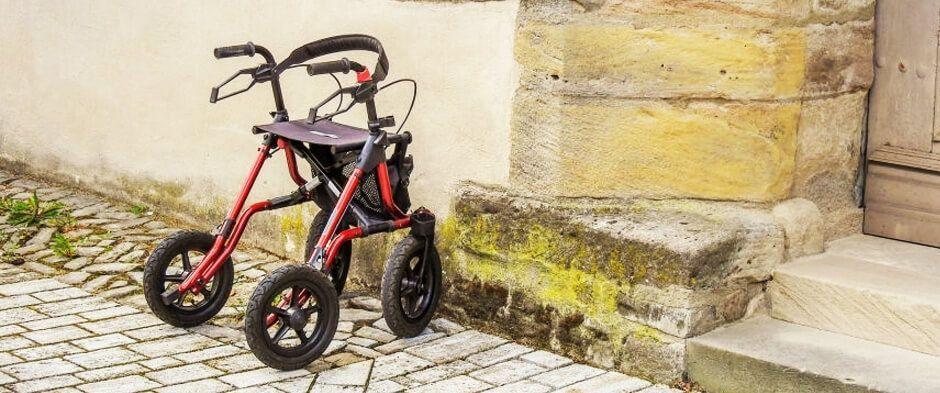
All You Need To Know About Wheeled Walkers and Rollators
Sally Madeley-Carr, OT09 Apr 2020
Walking aids with wheels can be transformative pieces of equipment for people with compromised mobility. They provide a moving support platform which helps with balance and in turn help to maintain someone’s independence. While there are numerous types of walking aid like sticks and crutches for sale online, it is sometimes wheeled walkers which can have the most radical impact.
Commonly known as rollators, wheeled walking aids have become a common sight on pavements around the country, as more and more people discover their benefits and adapt to using them. They comprise a robust frame made of metal tubing, with a wheel at the base of each leg.
They provide excellent support, taking part of the user’s weight as they walk.
Essential Aids supplies an extensive range of rollators, many with innovative features. Here we’ll run through some things to consider if you’re thinking of buying one.
Who needs a rollator?
People suffering with balance issues or those with reduced mobility might consider a wheeled aid like a rollator walker. It provides a mobile support frame which can be used inside the home or for trips to the shops. If you have difficulty walking distances without support and feel a walking stick is not adequate, you might consider trying one.
Most rollators have swivelling castor wheels which make it easy to change direction. Because they tend to be used by the elderly or people with limited strength, most are made from as light a metal as possible.
If you are considering a rollator, think about exactly where you are likely to use it. Remember that you require the strength and balance not just to roll it on smooth, even ground, but also over curbs and potentially other small obstacles. If you intend to take it on public transport, is it light enough to pick and carry on board?
Three or four wheels?
Rollator walkers are available with either three or four wheels. Generally speaking, four wheeled models offer more stability, while three-wheelers are easier to manoeuvre.
In both cases, the wheels themselves usually feature solid rather than pneumatic tyres. This is essentially to rule out the chance of puncture. As the user may well have some form of disability, it is important to minimise the risk of the rollator itself becoming immobile.
The size of the wheels is variable, with larger diameters generally offering a smooth ride and more ability to overcome obstacles.
Four wheeled models are generally wider, so consider this if you might find yourself in narrow corridors. When collapsed down for transportation or storage, three wheelers are more compact. They are also lighter in weight, so are better if you are likely to be lifting them on and off buses.
For heavier individuals, four wheeled walkers are usually the best choice. Bariatric models are available which are made of steel. These are heavier but considerably stronger than aluminium framed versions.
Brakes
With safety in mind, rollators are fitted with brakes. Typically they are cable brakes which operate similarly to those on a bicycle.
Another commonly found system engages the brakes when enough downward pressure is applied on the rollator. This function is primarily for rollators which have an inbuilt seat, ensuring the walker doesn’t roll away when it’s being sat on.
Seats
A rolling walker with a seat has one great benefit - it provides somewhere to rest when you’re on the move! For people prone to tiring while getting from A to B, this can be not just a luxury, but a necessity.
Only four-wheeled walkers have seats and many also have integral backrests. The seat itself is positioned in the centre of the frame, usually above a space for a shopping basket.
As mentioned, while it’s being sat on, some rollators have a brake locking mechanism which prevents the walker rolling unexpectedly.
In most cases, the seats are made of padded plastic, although on some walkers, like the ‘X Fold Rollator’ both the seat and backrest are made of flexible canvass. This helps keep the weight down and makes folding-up the rollator an easier process.
Shopping baskets and bags
Rollators are fantastic for taking the weight of your shopping without compromising mobility. On four-wheeled models, the basket is situated underneath the seat, which flips up to give access.
Three-wheelers usually don’t come with rigid under-seat baskets because of their more compact design, but many are available with soft bags which fix and hang down between the handlebars. In most cases the bag does not have to be detached in order to fold-down the rollator.
Some three-wheeled models have a small basket which is placed higher up at the front of the frame. Sometimes this is fitted with a tray on the top, which can be useful if the walker is used around the house.
Remember that these prevent the rollator from collapsing down. If you have shopping in the basket or bag and need to get on the bus, it might not be an easy process.
Essential Aids has a wide range of walking sticks and crutches for sale, and many of these can be used in combination with a rollator. Plastic clips let you attach them to the frame, so they can be carried without difficulty.
Most rollators come with some form of basket or bag, so they’re great for items you might otherwise have trouble carrying. Remember though, that if you need to collapse the walker down to for example get on a bus, you can’t do so with a full shopping basket.
Essential Aids Rollators
Essential Aids sells more than 50 types of rollator. As you see from the range, many have quite unusual tubing geometry. In each case this brings subtle differences to the way weight is distributed and the degree of control the user is able to exert on the steering and the balance of the device.
Your occupational therapist may be able to offer guidance on which type of rollator might best fit your requirements.
Combi wheelchair rollators
A recent innovation in rollator walkers has seen their design integrated with transit wheelchairs.
Essential Aids’ Duo Rollator and Transit Chair has a forward facing seat along with foot supports just like a conventional transit wheelchair. The rear-facing handles can be used for support in the same way as one would use a rollator, or they can be used to push someone sitting on the seat.
This inventive design makes this a particularly versatile piece of equipment. It folds down neatly so it is easy to transport in a car or tuck away for storage in a cupboard.
Extra seat padding
Essential Aids does wheeled walkers featuring extra-thick padded seats. The Comfort Rollator for example has a deep foam seat and also a deeply padded backrest. Its contoured, super-soft seat is great if you find harder seating uncomfortable.
It is worth noting that rollators without seats tend to fold down to smaller sizes than those with them. If you require a rollator which fits into a small storage gap or you need one which is especially lightweight, this is something to bear in mind.
Psychological factors
It is often the case that elderly people in particular are reluctant to start using mobility aids. This psychological barrier may reflect a desire to avoid giving the appearance of being either needy or disabled. Many view a mobility aid as giving a clear signal to the world that they are not well.
While this line of thought is understandable, it’s important to realise that if this psychological hurdle can be cleared, there are tangible, practical benefits to retaining one’s independent mobility for as long as possible. If there are tools available to help us achieve this, it is counter productive to ignore their existence.
Furthermore, the population of the UK is ageing and while mobility aids are common now, they will become even more so over the next 20 years. As they become routine for more and more people, the hope is that they will be normalised and any remaining perceived stigma will melt away.
Other walking aids
While a rollator walker or a walking frame with wheels might be the answer, Essential Aids has a wide range of crutches for sale along with traditional walking aids like sticks and canes. Like wheeled aids, these tend to be made of lightweight materials like aluminium, making them easy to lift and control.
Walking sticks with three or four legs can make a big difference to someone with impaired balance and essentialaids.com has a whole section devoted to these mobility aids.
In the scheme of walking aids, they fit somewhere between a basic walking stick and a walking frame, which provides even more support than a multi-foot stick.
For travelling longer distances, mobility scooters are also gaining in popularity across the UK. These are an electrically powered vehicle suitable for a single person.
There are different ‘classes’ of scooter available, with some suitable for pavement use and inside some shopping centres, while others are designed for the road itself.

Sally Madeley-Carr, OT
Sally qualified as an Occupational Therapist in 1996 and is a well-respected professional in the field of rehabilitation equipment and living aids. She has worked in private practice and within the NHS, developing a broad experience with adults and children. Click here for Sally's registration with the Health and Care Professions Council. The HCPC regulates health, psychological and social work professionals in the UK.